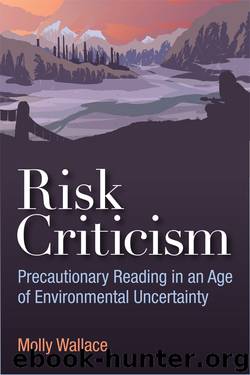Risk Criticism: Precautionary Reading in an Age of Environmental Uncertainty by Molly Wallace

Author:Molly Wallace
Language: eng
Format: epub
Publisher: University of Michigan Press
Published: 2018-05-15T00:00:00+00:00
Plastic Matters
In endorsing anthropomorphism, then, I join Jane Bennett and other advocates of the “new materialisms,” critical practices that emphasize the agential capacity of nonhuman things, whether organic or synthetic, born or made. My additional modifier of “strategic,” though, is intended to forestall a potential pitfall in some of this work. As amenable as I find the turns to “objects,” “things,” or “matter” in contemporary cultural and literary theory, as much as I view them to be a necessary and useful supplement to ecocriticism and ecocultural studies, I also find in them a tendency to level any distinction one might wish to make between different kinds of things, a tendency that can complicate an environmental ethics or politics that relies, often, on such delineation. This leveling is particularly symptomatic in the rhetorical technique of listing, which is common in this kind of work, whether in Timothy Morton’s “wind harps, egg cups, cathedrals, underwater gas pipelines, poems, neutron stars, PDFs, and grains of salt,”31 or Serenella Iovino’s “stories, bodies, landscapes, bacteria, electric grids, quantum entanglements, waste dumps, animal testing, cyborgs, cheese, nuclear sites, oceanic plastic, art, time, nature,”32 or Serpil Oppermann’s “water, Page 131 →soil, stones, metals, minerals, bacteria, toxins, electricity, cells, molecules and atoms, and a vast array of nature’s constituents as well as culture’s trash and garbage.”33 Such interventions are directed at undermining what is perceived to be an artificial and problematic binary between nature and culture, a binary that critics perceive ecocriticism as endorsing. Patricia Yaeger has suggested, for instance, that ecocriticism is “so contaminated with nature as perfection or with a quest for organic truth that operating in its name is hard.”34 Given the direction of recent work in ecocriticism, I find Yaeger’s fears about operating in its name to be a bit misplaced. Certainly those of us influenced by Donna Haraway, Bruno Latour, and Ulrich Beck are already working in the interstices between those problematic binary terms. But the effect of the rhetorical move of listing is often to blur that admittedly problematic nature/culture binary by implying sameness (all items in the lists have “agentic capacity,” as Oppermann reminds us).
Of course, the fact that all matter is “lively” need not mean that all of its actions are the same—or that all matter and its actions should be valued in positive terms. It is precisely because all things have agency that one ought to distinguish among them. Cheese and nuclear sites, oceanic plastic and bacteria—these may be lively, but they differ in their life-supporting or biopolitical implications. And in making these sorts of distinctions among lively things, some recourse to—again, strategic—language of nature or the organic may be necessary. At the end of Vibrant Matter, Jane Bennett speculates on some of the ethico-political pitfalls of her own endorsement of a lively materialism, noting that, whatever its epistemological or theoretical problems, “the ideal of nature as the Wild continues to motivate some people to live more ecologically sustainable lives.” And she notes that, even she herself, a convert
Download
This site does not store any files on its server. We only index and link to content provided by other sites. Please contact the content providers to delete copyright contents if any and email us, we'll remove relevant links or contents immediately.
4 3 2 1: A Novel by Paul Auster(11107)
The handmaid's tale by Margaret Atwood(6905)
Giovanni's Room by James Baldwin(5945)
Big Magic: Creative Living Beyond Fear by Elizabeth Gilbert(4770)
Asking the Right Questions: A Guide to Critical Thinking by M. Neil Browne & Stuart M. Keeley(4633)
On Writing A Memoir of the Craft by Stephen King(4257)
Ego Is the Enemy by Ryan Holiday(4027)
Ken Follett - World without end by Ken Follett(3998)
The Body: A Guide for Occupants by Bill Bryson(3868)
Bluets by Maggie Nelson(3746)
Adulting by Kelly Williams Brown(3710)
Guilty Pleasures by Laurell K Hamilton(3625)
Eat That Frog! by Brian Tracy(3557)
White Noise - A Novel by Don DeLillo(3454)
The Poetry of Pablo Neruda by Pablo Neruda(3395)
Alive: The Story of the Andes Survivors by Piers Paul Read(3341)
The Book of Joy by Dalai Lama(3265)
The Bookshop by Penelope Fitzgerald(3249)
Fingerprints of the Gods by Graham Hancock(3242)
